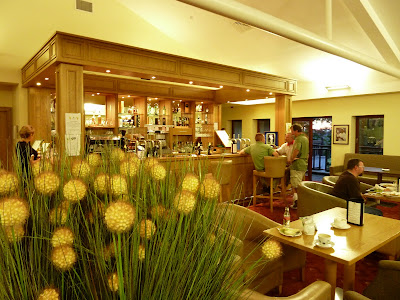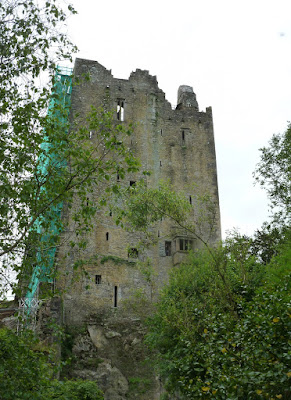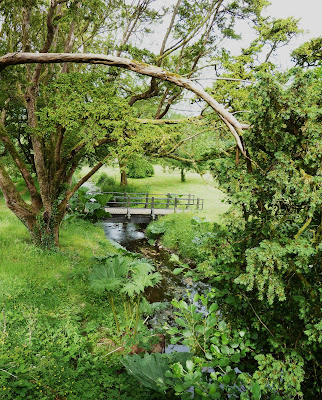.JPG)
Blarney Castle (Caisleán na Blarnan) near Cork, is the place where one finds the Blarney Stone, (Cloch na Blarnan) a block of bluestone built into the battlements, or machicolations of the castle. Kissing the Blarney Stone confers the "gift of gab" or eloquence on the kisser. I already am quite able to tell stories--ask my former students--but perhaps my abilities could stand upgrading. It would be worth the effort!
I remembered that George Bernard Shaw, one of my favourite great Irish writers, had said he felt he did not need the ritual of kissing the stone because he was already eloquent:
"My natural gifts in that direction being sufficient, if not somewhat excessive."
This was our destination, as we drove from our hotel north of Dublin, south through the Wicklow Hills to Wexford.
I had discovered on-line a perfect place for a family group of six to stay for our visit to Blarney Castle. Located just outside the village, in Tower, is the Blarney Golf Resort, which advertises itself as a World Class Resort. Located on 170 acres in the Shournagh Valley, it offers stunning views of the Irish countryside. Not only is there a luxurious 4-star hotel, there are 56 lodges, built like townhouses, which gave us spacious accommodations.

Just off the back door is the golf course where I wandered, admiring the scenery and watching the rabbits, before the first golfers started their games. The golf course looks good and is described as a “signature championship golf course co-designed by two-time Major winner, John Daly.”




We ate supper in the Lions Den Golf Clubhouse and enjoyed excellent pizzas. A large group of thirty-something women were having a celebration of some sort in the dining room and they were quite noisy in their excitement. It didn’t matter because it added to the merriment. Breakfast was served in the hotel, but it was also very noisy with a group of undisciplined Italian school children romping about as I tried to enjoy an Irish breakfast. We did not get to use the spa or enjoy the swimming pool.

Blarney Castle is close by the golf resort and we were amongst the first to arrive, again on a beautiful sunny day. As fond as I am of snapshots of the sites I visit, I was initially disappointed to see that Blarney Castle is wrapped in plastic, undergoing restorative maintenance. Once inside, it was obvious to me how much work it needs. In fact, I kept wondering what keeps it from tumbling down, as it seems this close to being in ruins! Its walls may well be 18-feet-thick in places, but that possibility gave me no reassurance. The completely irregular stones that twist and turn on the stairs and walkways were also physically challenging!


Blarney Castle itself has a long and curious history. The castle originally dates from before AD 1200, when a wooden structure was built on the site. After 1210 this was replaced by a stone fortification.Though earlier fortifications were built on the same spot, the current keep was built by the McCarthy clan and dates from 1446. When rebuilt by Cormac MacCarthy, then King of Munster, apparently the stone was set into the castle wall.
After the Restoration the castle was restored to Donough MacCarty, who was made 1st Earl of Clancarty. The castle was sold and changed hands a number of times before being purchased by Sir James St. John Jefferyes.


.JPG)



Above, on the parapet, is the Blarney Stone, my destination. The stone is said to have been presented to Cormac McCarthy by Robert the Bruce in 1314 in recognition of his support in the Battle of Bannockburn.
Popular legend holds that this was a piece of the Scottish Stone of Scone, also called the Stone of Destiny or the Coronation Stone.
This stone was then installed at McCarthy's castle of Blarney. When the castle was rebuilt in 1446, Dermot McCarthy had the stone preserved in the new castle. Although colourful, this folk legend cannot be true as the stone was removed from Scotland 18 years before Bannockburn.
.JPG)
We climb the 100 steps needed to reach the parapet and to look down into the gap at the bottom of which the Stone is embedded.


The proprietors of Blarney Castle list several other explanations other than the Stone of Scone for the ancient origins of the Blarney Stone, many of which suppose that the Stone had previously been in Ireland but was then taken to Scotland and returned to Ireland in 1314.
Apart from the possibility that it was part of the Stone of Scone, other beliefs are that the Blarney Stone:
§ was part of the wailing wall in Jerusalem brought to Ireland during the Crusades.
§ was the stone that Jacob used as a pillow, and was brought to Ireland by the prophet Jeremiah.
§ was the pillow used by St. Columba of Iona on his deathbed.
§ was the Stone of Ezel which David hid behind on Jonathan’s advice, while fleeing from King Saul and may have been brought back to Ireland during the Crusades.
§ was the rock that Moses struck with his staff to produce water for the Israelites, during their flight from Egypt.
§ was related to the stone was known as the Lia Fáil or "Stone of Destiny" - part of the king's throne, with mysterious powers.
None of these provenance stories account for why a stone of such significance and antiquity would be used in the construction of a fifteenth century castle, inconspicuously incorporated into an exterior wall and exposed to the elements. Apart from discoloration and wear caused by human contact, the stone is not readily distinguishable from its neighbours. It has recently been named the most unhygienic tourist attraction in the world.

I knew that I would have to bend over backwards to kiss the Blarney Stone, but had I known that it meant being held over a gaping hole in the battlements above the ground--even with metal rails to grasp--I might have thought twice about doing it! My daughter decided not to go through the ritual, perhaps echoing Bernard Shaw's claims.
.JPG)
It was not an easy position for an old goat like me, and it took two men to get me back on my feet, for which effort I gratefully gave them a two-euro coin.

.


There is an official photographer at the place, and each digital image is sent electronically to the gift shop where one may purchase them for €9 each. Of course there are two, one of the kissing of the Stone and the other of getting up again.

Another thing I had not realised is that the floors of the castle are mostly gone, so that what is left is a gaping hole or inner courtyard. The interior rooms are all gone. I noticed a sign somewhere that said cattle used to roam about inside quite recently.







Next to lower fortifications is the Poison Garden, some of the plants in iron cages. My family suggested repeatedly that I should pick this flower or eat that plant!




In its time, Blarney Castle must have been a formidable fort or keep. We could not take photos in the Badger Cage, a deep tunnel that some believe goes for miles, an escape route from the castle.








As we walked through the gardens we heard lively Irish music dancing over the hedges. Two musicians were playing tunes for the tourists.

From the battlements atop the castle we had seen Blarney House, the privately owned house and gardens located here.


The house is only opened for a short time in the summer, but it would require an hour’s wait and another fee to tour inside.

Members of the Jefferyes family built a mansion near the keep. This house was destroyed by fire however, and in 1874 this replacement baronial mansion - known as Blarney House - was built overlooking the nearby lake.


The gardens at Blarney are quite pleasant, with many trees, especially on the Castle Field Arboretum along the River Martin.

We chose not to walk through the Rock Close, described as “a mystical place on the site of an ancient druidic settlement.” There we could have seen a Druid Cave & Circle, a Witches Stone, a Sacrificial Altar and even a Fairy Glade.



It was time to move on as we wanted to keep to our planned itinerary, which today meant driving around the Ring of Kerry. Our intention was to drive from east to west, as we had reservations northwest in Limerick. But somehow our navigation system put us on the western side.


We pulled over for a quick stop where I was reminded of my two favourite Irish balladeers, Tommy Makem & Liam Clancy. It was not easy in our travel situation to hear authentic Irish music. I think that would have to be a separate schedule.


Eventually we arrived for an hour’s rest in the seaside town of Waterville, (An CoireÁn, “The Little Whirlpool”) where we found a couple of surprises. One, of course, was the food, and we chanced upon the Red Lobster Bar where the fare was very good.


Waterville is on the eastern shore of Ballinskelligs Bay, on a strip of land that separates the sea from the lake Lough Currane, which we couldn’t see. The pretty town in on the Iveragh Pennisula.

Mo Léar (My Sea)
So there you go, for good, smiling, swearing, eyes thrown to heaven,
With never a drop of bad blood between you and the wide, wide world.



"For the man who made the movies speak in the hearts of millions, Charlie spent many years in our midst as a humble and guest and a friend to many. This image was created by Alan Ryan Hall. It was funded by the generosity of Josephine Chaplin and by the EU leader programme."



Toward Ballinskelligs (Baile an Scelge) and Bolus Head.




Derrynane Bay, below Caherdaniel (Cathair Dónall). Just 1 mile away is Derrynane beach, house and gardens. The house was the home of Daniel O'Connell, famed in Ireland as "The Liberator" (1775 - 1847), who won Catholic representation in Parliament in 1829.

Towards Lamb’s Head & the River Kenmare, which looks like a bay!

The islands of Scariff & Deenish.


Towards Muchmoss Lake & Lough Leane to Killarney, from Killarney National Park. Our tour of the Ring of Kerry began and ends in Killarney.
This has been a long day of driving, and we have to pass many beautiful vistas and skip wonderful little villages--such as Adare, near Limerick--described as one of the most beautiful villages in Ireland--as we need to get to our hotel in Limerick for the night. Driving through Ireland as we must do it, according to pre-booked reservations, means much is missed. Driving like this means it can be very difficult to capture the scenery. Certainly, snapshots cannot capture the feelings that the hills and colours of the Emerald Isle evoke. Tomorrow we visit Bunratty Castle and Folk Village and then head to the majestic Cliffs of Moher.
